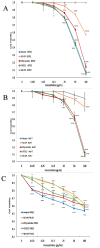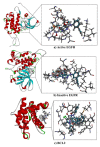Lepidium sativum Secondary Metabolites (Essential Oils): In Vitro and In Silico Studies on Human Hepatocellular Carcinoma Cell Lines
- PMID: 34579396
- PMCID: PMC8470406
- DOI: 10.3390/plants10091863
Lepidium sativum Secondary Metabolites (Essential Oils): In Vitro and In Silico Studies on Human Hepatocellular Carcinoma Cell Lines
Abstract
Hepatocellular carcinoma (HCC) is the most common primary liver cancer and the greatest cause of cancer-related death in the world. Garden cress (Lepidium sativum) seeds have been proven to possess extraordinary antioxidant, anti-inflammatory, hypothermic, and analgesic properties. In this study, in vitro cytotoxic efficiency evaluation of L. sativum fractions was performed against two hepatocellular carcinoma cell lines (HuH-7 and HEPG-2), and the expression of some apoptotic genes was explored. In addition, the chemical composition of a potent extract of L. sativum was analyzed using gas chromatography coupled with mass spectrometry. Then, molecular docking analysis was implemented to identify the potential targets of the L. sativum components' most potent extract. Overall, the n-hexane extract was the most potent against the two HCC cell lines. Moreover, these cytotoxicity levels were supported by the significant downregulation of EGFR and BCL2 gene expression levels and the upregulation of SMAD3, BAX, and P53 expression levels in both HuH-7 and HEPG2 cell lines. Regarding L. sativum's chemical composition, GC-MS analysis of the n-hexane extract led to the identification of thirty compounds, including, mainly, hydrocarbons and terpenoids, as well as other volatile compounds. Furthermore, the binding affinities and interactions of the n-hexane fraction's major metabolites were predicted against EGFR and BCL2 molecular targets using the molecular docking technique. These findings reveal the potential use of L. Sativum in the management of HCC.
Keywords: GC–MS analysis; Lepidium sativum; apoptosis; garden cress; hepatocellular carcinoma; molecular docking; qPCR.
Conflict of interest statement
The authors declare no conflict of interest.
Figures





References
LinkOut - more resources
Full Text Sources
Research Materials
Miscellaneous

